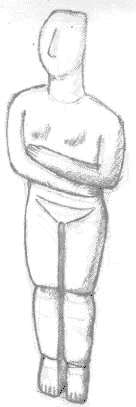| CYCLADES |
The commonest type is a naked woman standing on tiptoe with head tilted back and arms crossed over the breast(fig.2). The flat head is usually oval in shape with the flatter at the top. The nose is generally modeled as a high ridge and the eyes and the mouth were painted. A few examples are male figures playing harp or pipe. Some scholars consider these idols were buried in tombs as maids serving dead persons such as Egyptian Shabti figures. The others think these were amulets or statuettes of goddesses or nymphs. In the Early Cycladic III period, 2300-2000 B.C., the manufacture of these figures fell off sharply and disappeared in Middle Cycladic period. |
||
| Renfrew, C.,"The Development and Chronology of the Early
Cycladic Figurines" AJA73 (1969) J.Thimme (ed.), "Art and Culture of the Cyclades in the Third Millenium B.C." (1977) Colin Renfrew and Christos Doumas, "The Cycladic Spirit: Masterpieces from the Nicholas P. Goulandris Collection" (1991) R.Higgins, "Minoan and Mycenaean Art" (1997) J.Lesley Fitton, "Cycladic Art" (1999) |
||

